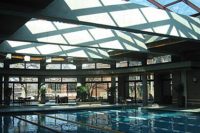The design and magnitude of a new residential indoor pool built onto a 21,000-square-foot, 100-year-old home named “Daybreak” in Montclair, New Jersey, confronted mechanical engineers with psychrometric and sustainability challenges on par with huge commercial indoor waterparks.
The 2,500-square-foot, two-story-high, rectangular pool enclosure features 21-foot-tall glass on three sides. The towering windows afford swimmers open, uncropped views of the 1.7-acre property’s aesthetic backyard landscaping that treks upward toward the First Watchung Mountain’s peak.
The substantial amount of windows proved challenging for consulting engineers, Vladimir Ayzenberg, P.E., director of engineering, and Lucien Nicolae, P.E., design engineer, both from Jarmel-Kizel Architects. The HVAC design guarantees condensation-free windows to maintain the views even during sub-zero winter days.
“Architects and building owners love a lot of windows in indoor pools, but engineers don’t, because they’re difficult to keep free of condensation during wintertime dew points,” said Edward G. Sneed III, HVAC manager, Stillwell-Hansen Inc., Edison, New Jersey, a manufacturers’ representative for Seresco USA, which supplied the project’s mechanical HVAC dehumidifier. “However, with the right building materials, HVAC equipment sizing, air distribution, and other good engineering practices, condensation can be eliminated regardless of the amount of glass.”
The project’s HVAC design is anchored by a Seresco NE Series dehumidifier. Installed on the pool enclosure’s rooftop by mechanical contractor Reiner Group Inc., the 8,000-cfm unit can dehumidify to 50 percent rh and heat/cool the space while simultaneously providing eight volumetric air changes per hour. It recovers compressor operation waste heat to provide free pool water heating at a significant energy savings. Additional efficiency comes from its electronically commutated (EC) direct-drive fan motors. The dehumidifier also features a condenser with owl wing fan blades, which maintains quietness near the home’s bedroom windows.
While Seresco manufactures mechanical dehumidifiers ranging up to 140 tons for large facilities with tremendous humidity loads, such as indoor waterparks, the 16-ton NE Series is one of the largest dehumidifiers it has manufactured for a residential application, according to Mark Palitza, the company’s national sales manager. The size of most residential indoor pools requires a smaller 4- to 8-ton dehumidifier and only single-phase electric service; however, the volumetric size and substantial amount of glass in the two-story building, combined with the significant evaporative rate of a large 20-by-40-foot pool and 8-by-8-foot spa, mandated a 16-ton dehumidifier. This far surpasses the dehumidifier size of most hotel and health club indoor pools. Instead of three 6-ton units running on single-phase electric, the local utility made the exception of running three-phase electrical service to the household to handle the 16-ton unit’s requirements. One large unit saved the homeowner thousands of dollars in installation and future maintenance costs versus three units.
Figuring prominently in Jarmel-Kizel’s proper dehumidifier sizing was querying the homeowner on the pool’s foreseeable uses, an important design process step that ensures the unit is sized correctly to cover the needs and expectations for the space. Thus, Jarmel-Kizel’s design team discovered the homeowner’s unconventional proposed water and space temperatures (90°F water, 82° space). This differential produces significantly higher evaporative rates than the 2º differential (such as 80° water, 82° space) recommended in the natatorium chapter of the ASHRAE handbook. Furthermore, the homeowner also wanted the flexibility of a 78° “party mode” air comfort temperature for occasional charity fund-raising parties.
Jarmel-Kizel’s specification of a dual-compressor dehumidifier and a pool cover will save the homeowner thousands of dollars annually in energy savings. Both strategies take into account that the homeowner uses the pool area a small percentage of the day. The dual compressor strategy operates one 8-ton compressor to maintain rh during idle times and the majority of family swim periods. The second compressor is automatically activated by the dehumidifier’s CommandCenter if space temperature or rh levels aren’t satisfied, such as during extremely cold days, startups after retractable window closing, or during party mode. The automatic pool cover manufactured significantly reduces pool water evaporation, thus compressor run-times during idle periods.
The air distribution design is equally important as the dehumidifier for keeping windows clear of condensation. A 24-inch-diameter, spiral metal rooftop drop and metal tee supply two 24-inch white fabric duct lines. The duct is mounted 10-feet high and nearly encircles the perimeter. It is supported by custom-fabricated, white, architectural, wall-hanging brackets. Jarmel-Kizel ordered a linear air diffusion pattern at 10-o’clock and 8-o’clock to keep the windows above and below bathed evenly in warm, dehumidified air that’s above the outdoor dew point.
The homeowner uses Seresco’s proprietary WebSentry®, a web browser-based monitor and control interface to help keep the HVAC system running as efficiently as possible. Where older dehumidifiers can run inefficiently for months in between annual service check-ups, the homeowner’s smartphone app allows him to log-in and access real-time and historical data reported from the CommandCenter for more than 60 operating parameters or receive an alarm within seconds of an operational inefficiency.
Thanks to modern technology and intuitive engineering, the homeowner will save hundreds of thousands of dollars in energy savings during the indoor pool’s life cycle.



